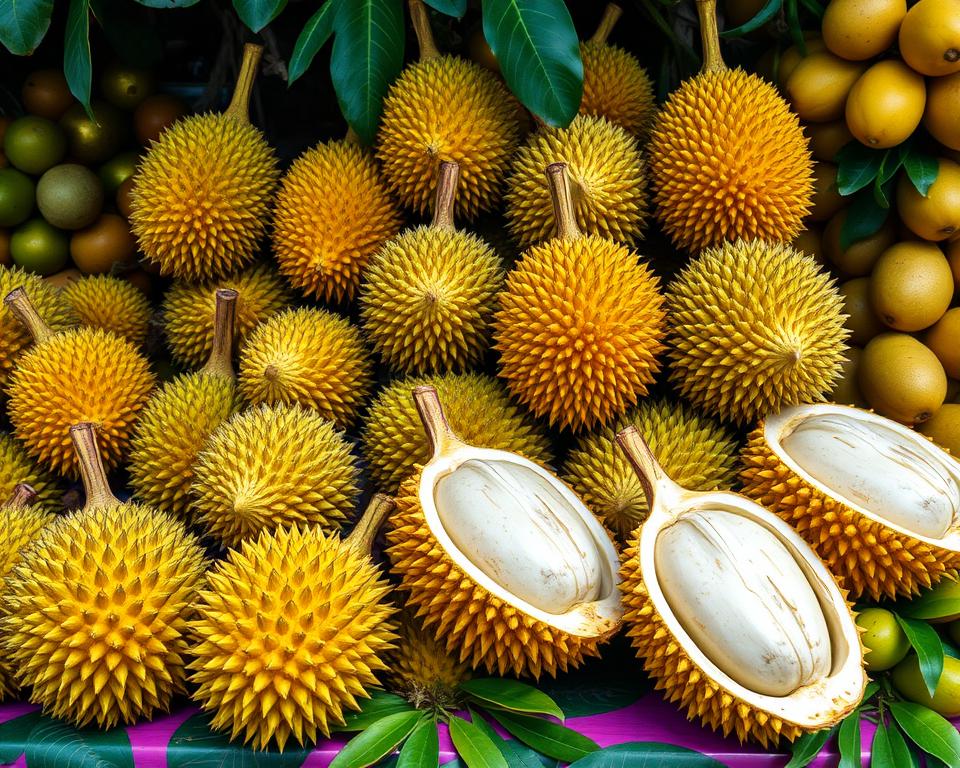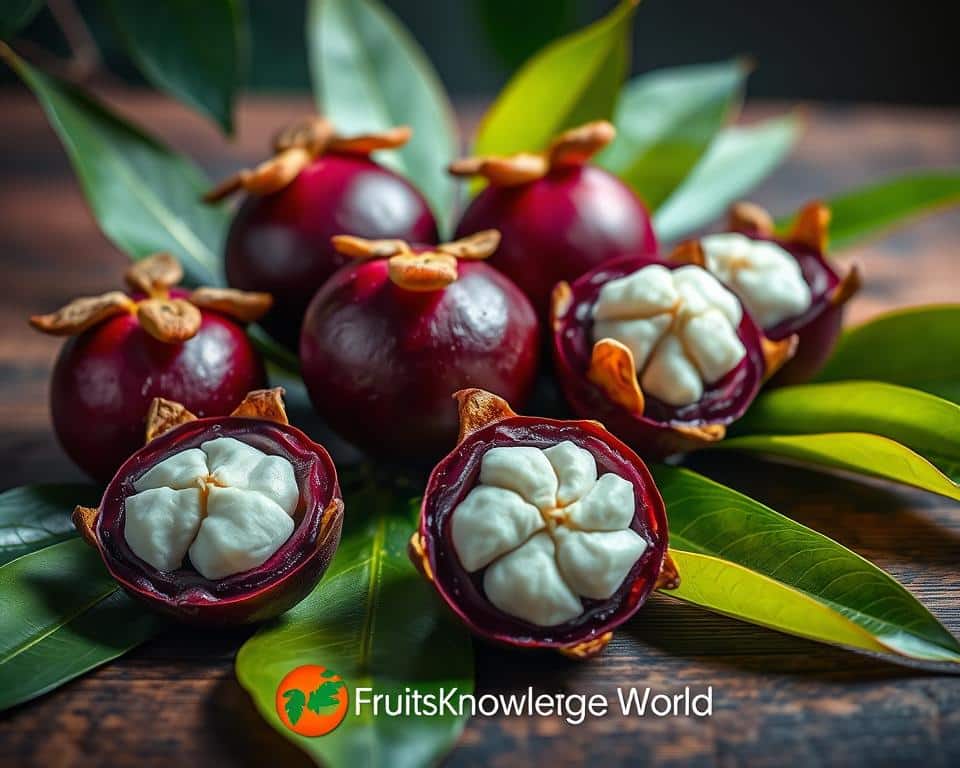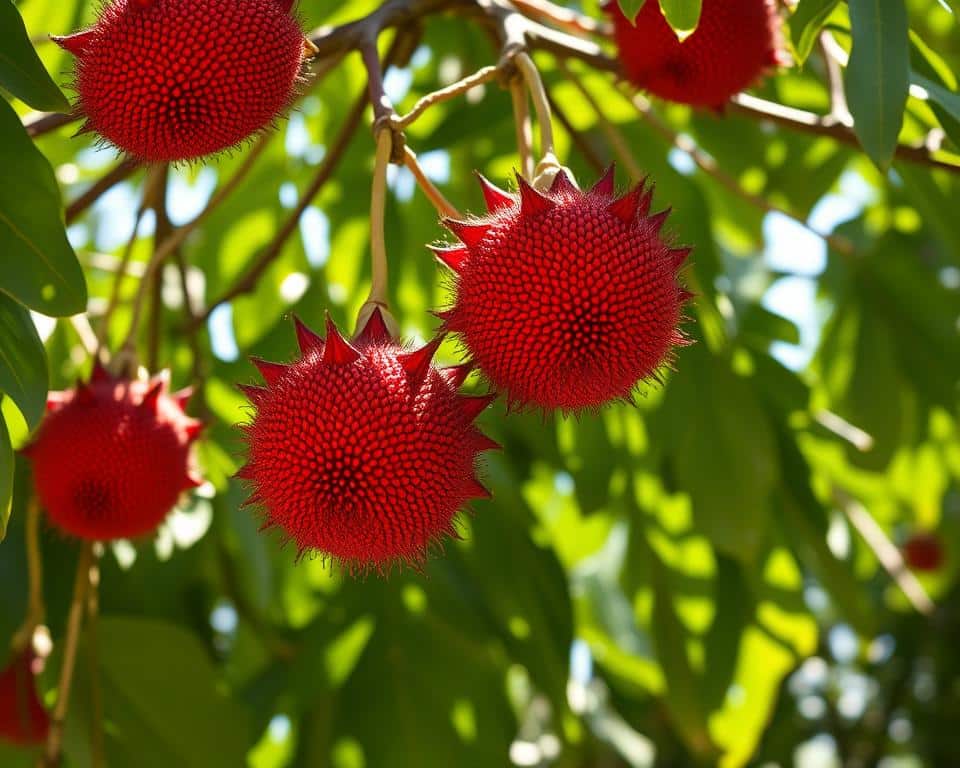If you’ve visited Southeast Asia, you might have come across the durian. Known as the “King of Fruits,” it’s famous for its strong smell and unique taste. It’s a fruit that people either love or hate. The smell is so strong it’s banned on buses and trains in places like Singapore. But for many, tasting durian is more than just about flavor. It’s a cultural experience that unites people in a special way.
Key Takeaways
- Durian is known as the “King of Fruits” in Southeast Asia.
- It has a potent smell, often likened to rotting eggs and sewage, resulting in bans in public spaces.
- This unique fruit is considered a Southeast Asian delicacy despite its divisive nature.
- Durian is the most expensive fruit, with one specimen sold for $48,000.
- Consuming durian can leave a lingering scent due to its volatile sulfur compounds.
The Distinctive Appearance and Aroma of Durian
The durian is known for its distinct look and strong smell. It’s memorable from the first glance to the first sniff.
Appearance
The durian appearance grabs attention with its unique look. It has a large, oval shell with sharp durian spikes. These spikes protect the creamy inside. Many love this fruit for its soft, savory center. A durian can be up to seven pounds, making it a hefty find. Despite its tough exterior, the inside is a sought-after delicacy.
Aroma
The potent durian smell truly makes this fruit stand out. It is a mix of sweet custard and a strong, off-putting odor. The stinky durian splits opinions. Its smell is so strong that it’s not allowed on public transit in some Asian places. Once you smell it, you won’t forget it.
The durian’s smell stays even after it’s eaten, making it a notable experience. Whether liked or not, its potent durian smell makes it unforgettable.
The Health Benefits of Durian
Durian is known as the durian superfruit and is loaded with important nutrients. It has a strong smell but offers a lot of nutritional value. This fruit is great for your health.
Nutritional Content
A single cup of durian contains 357 calories, which provides a lot of energy. It has 13 grams of fat, mostly good fats, and 66 grams of carbs. There’s also 9 grams of fiber in it, helping with digestion and fulfilling a third of your daily fiber needs.
Durian is also rich in vitamins and minerals. It gives you 80% of your daily need for Vitamin C, which is key for your immune system. You’ll also get a lot of Thiamine, Manganese, and Vitamin B6. Plus, it has 30% of the daily need for Potassium, which is important for your heart and muscles.

Health Improvements
Durian’s high fiber is good for your heart and can help you manage your weight. Eating more fiber can help you lose or maintain weight, as research has shown.
This fruit’s Vitamin C is great for your skin. It protects your skin from damage, which can reduce spots and wrinkles. The potassium in durian can help lower blood pressure. This is a big deal because many adults in Singapore have high blood pressure.
Durian can also help make your muscles stronger, even though it has just a bit of protein. Its vitamins and minerals support muscle recovery and function. Minerals in durian can make your bones stronger and prevent bone-related illnesses. For more details on its benefits, check out this study on durian’s nutritional and medicinal benefits.
Adding durian to your diet can offer many health advantages. It’s good for your skin, muscles, and heart.
Varieties of Durian
Durian shows off a vast range of varieties. Each one offers unique tastes and textures. Originally from Malaysia, Indonesia, and Borneo, durian growth has spread worldwide. This expansion has greatly influenced agriculture.
Different Types
Some durian types are especially popular because of their distinct features:

- Monthong: Called the “golden pillow,” Monthong covers about 41% of Thailand’s durian areas. Its fruits range from 2-6 kg. They usually bear fruit after eight years.
- Chanee: An early fruiting variety, Chanee’s fruits weigh about 2-4.5 kg. It constitutes 33% of Thailand’s durian areas, with fruits appearing 4-6 years after planting.
- Kan Yao: Making up 5% of the durian areas, Kan Yao’s fruits are 2-4.5 kg. They also fruit within 4-6 years.
- Gradum-tong: Commanding 2% of the durian areas, Gradum-tong produces 2-4 kg fruits. These trees bear fruit 4-6 years after planting.
Besides these, many lesser-known durian varieties contribute to this fruit’s cultivation diversity. People’s choice often depends on local tastes and growing conditions.
Geographical Distribution
Durian farms’ locations reveal much about this fruit’s global appeal. Key cultivation areas include Malaysia, Indonesia, Thailand, Sri Lanka, Southern India, Vietnam, and China. Thailand is the leading durian exporter. This success comes from both small and large farms meeting worldwide demand. Exploring durian cultivation sheds light on its cultural and economic role in Southeast Asia.
In Thailand, the government has registered over 234 durian types. About 60-80 of these are grown for sale, highlighting a broad range of flavors and textures. They are among the most valued fruits in Southeast Asia.
| Variety | Weight (kg) | Time to Bear Fruit | Percentage of Cultivation Area |
|---|---|---|---|
| Monthong | 2-6 | 8 years | 41% |
| Chanee | 2-4.5 | 4-6 years | 33% |
| Kan Yao | 2-4.5 | 4-6 years | 5% |
| Gradum-tong | 2-4 | 4-6 years | 2% |
Learning about durian types and where they grow helps us value the effort to cultivate them. Each variety makes the durian legacy richer and more intriguing, offering distinct tastes to enjoy.
The Unique Taste of Durian
Exploring the taste of durian is like going on an adventure. It’s called “The King of Fruits” for good reason. In Malaysia, Singapore, and Southeast Asia, people either love it or hate it. This makes it a hot topic in food talks all around the globe.
First Impressions
The first time you try durian, you might not be sure what to think. Back in 1662, Jacques de Bourges, a missionary, really liked it. He thought it was as good as the fancy fruits in Europe. But, people today, like Anthony Bourdain, have mixed feelings. Bourdain said it tastes like strong French cheese. Andrew Zimmern thought it was like “rotten onions.” That’s why trying durian is something you won’t forget.
Developed Taste
But for those who love durian, the adventure doesn’t stop at the first try. After the shock, you find a creamy, complex taste. The Oxford Companion to Food says its flavor is hard to pin down, from sewage to cheese. Thomas Fuller from New York Times found it tastes like hazelnuts, apricots, bananas, and custard. As you get used to it, you’ll love its custardy texture, like cheesecake. Fans can’t wait for durian season to enjoy this taste.
Durian’s aroma is complex, but give it a chance. Going from doubt to liking it shows its unique charm. It’s called the king for a reason. It attracts and fascinates those willing to try this special flavor.



